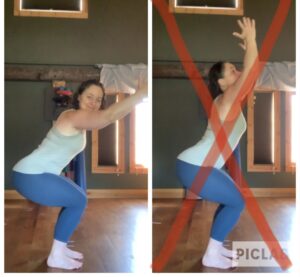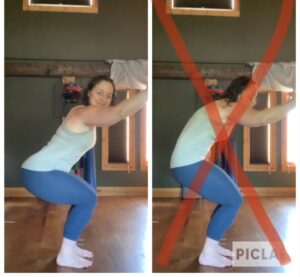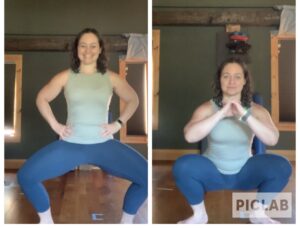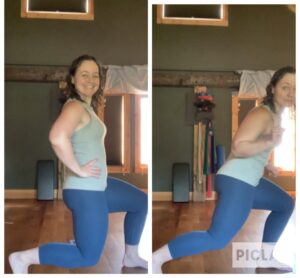A number of people are afraid to do lunges and squats because they think the moves are bad for their knees. If you have knee issues, you may need to modify, take precautions, or starts slow and small, but you don’t want to cut lunges and squats out of your exercise routine. We need to keep those muscles strong because we squat and lunge in many practical ways throughout the day.
You squat to get off the toilet, up from a chair, in and out of the car, to get down and up off the floor. And if you want to lift something heavy using your legs and not your back, you need to be able to do a deep squat (otherwise your back is still very involved).
So let’s talk about form so that we can do these moves safely:
Basic Squat:
- Legs hip distance apart. That might be closer than you think. It’s where your femurs (bones in your thighs) come into your pelvis, not where you’d put your hands on your hips.
- All ten toes pointing forward.
- Then crease at your hips, stick the butt out and let your torso hinge forward holding a neutral spine—trying not to overarch (keeping the chest up) or round the back.
- Hands can reach overhead as you go down or stay on your hips.
- Stay heavy in your heels
- When you press up out of the squat, press into your feet as if you are pushing the floor away from you and squeeze your glutes…but DO NOT push your whole pelvis forward at the top. Just come back to a straight line.
Wide Squat:
- In this variation you start with legs wide and in turn out.
- When you squat the knees should track over the middle of your foot, not buckling in toward each other (this requires inner thigh flexibility).
- In this squat you keep the torso upright and try not to hinge forward. Remember to stay neutral and not overextend the back as you go down.
- Again, press up by pushing into your feet and thinking of pressing the floor away.
Deep Squat:
- For most people to do a deep squat you need to bring your feet a little closer than you had them in the last position, but you are still in turn out.
- Then lower down as low as you can, leading with the butt, trying not to hinge forward or round the back.
- Try to hang out down there for a bit.
- This is a hard one for many people since we don’t spend a lot of time in this position.
- Here are some tips if it’s new to you or you feel like you are far away from being able to do it. At first simply sit on a low step stool in this position. Start to feel comfortable just existing here with your body supported. Or, hold onto something that can support your body weight (like a strong door jam), and use it for support as you lower down.
Static Lunge:
- Take a wide stance (one leg forward, one back). This can be a balance challenge, so use a wall if you need one.
- Make sure all ten toes are forward again. The back foot often turns out, but it shouldn’t.
- Lift the back heel off the floor. It will stay up the whole time.
- Lead with the back knee and bend both knees lowering straight down.
- Think elevator, not escalator. There is no forward movement on a basic static lunge.
- While it will increase the balance challenge, throughout the move you should be able to lift your front toes off the ground. If you can’t, you’ve got too much weight forward.
- You should feel both quads (front of the thighs) working, but you want to make sure you feel the back one not just the front. People often make this a front leg exercise.
- Throughout the move your torso is always vertical over your back leg.
Research showing that squats are safe for the knees has been pretty definitive for 30 years. Yet they still make people nervous. Trust that the move doesn’t have to come all at once. It should not hurt your knees while you are doing them, so if the knees hurt that’s a sign something isn’t aligned right or a muscle isn’t engaging properly. You may need to start smaller or with fewer repetitions. That’s okay.
But you don’t want to give up on squats and lunges. When you do, you give up on so much of life. And if you are a lover of squats, you want to ensure your form is good so that you can do them lifelong!
CT Live
Keep Reading
Interested in perfecting your lunge? See how to do proper lunge form!
Squats and lunges hurting your knees? Hear what Maggie has to say about pain during exercise.
Keep Connected
Order Your Copy of Keep Moving Today!
Subscribe to the Keep Moving Blog
Like the Personal Euphoria Facebook page
Find us on Twitter
Follow me on Instagram
Subscribe to my YouTube Channel




